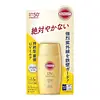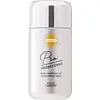What's inside
What's inside
 Key Ingredients
Key Ingredients

 Benefits
Benefits

 Concerns
Concerns

No concerns
 Ingredients Side-by-side
Ingredients Side-by-side

Water
Skin ConditioningCyclopentasiloxane
EmollientZinc Oxide
Cosmetic ColorantAlcohol Denat.
AntimicrobialEthylhexyl Methoxycinnamate
UV AbsorberIsododecane
EmollientCaprylic Acid
CleansingC12-15 Alkyl Benzoate
AntimicrobialSilica
AbrasiveTrimethylsiloxysilicate
EmollientDiethylhexyl Succinate
EmollientDiethylamino Hydroxybenzoyl Hexyl Benzoate
UV FilterPolysilicone-15
UV FilterBis-Ethylhexyloxyphenol Methoxyphenyl Triazine
Skin ConditioningChamomilla Recutita Flower Extract
MaskingSalvia Officinalis Leaf Extract
CleansingTocopherol
AntioxidantSodium Hyaluronate
HumectantSimmondsia Chinensis Seed Oil
EmollientHydrolyzed Collagen
EmollientButylene Glycol
HumectantBHT
AntioxidantAcrylates/Ethylhexyl Acrylate/Dimethicone Methacrylate Copolymer
Skin ConditioningStearoyl Inulin
EmollientTriethoxycaprylylsilane
Polyhydroxystearic Acid
EmulsifyingLauryl PEG-9 Polydimethylsiloxyethyl Dimethicone
Skin ConditioningSodium Lauroyl Glutamate
Phenoxyethanol
PreservativeWater, Cyclopentasiloxane, Zinc Oxide, Alcohol Denat., Ethylhexyl Methoxycinnamate, Isododecane, Caprylic Acid, C12-15 Alkyl Benzoate, Silica, Trimethylsiloxysilicate, Diethylhexyl Succinate, Diethylamino Hydroxybenzoyl Hexyl Benzoate, Polysilicone-15, Bis-Ethylhexyloxyphenol Methoxyphenyl Triazine, Chamomilla Recutita Flower Extract, Salvia Officinalis Leaf Extract, Tocopherol, Sodium Hyaluronate, Simmondsia Chinensis Seed Oil, Hydrolyzed Collagen, Butylene Glycol, BHT, Acrylates/Ethylhexyl Acrylate/Dimethicone Methacrylate Copolymer, Stearoyl Inulin, Triethoxycaprylylsilane, Polyhydroxystearic Acid, Lauryl PEG-9 Polydimethylsiloxyethyl Dimethicone, Sodium Lauroyl Glutamate, Phenoxyethanol
Cyclomethicone
EmollientZinc Oxide
Cosmetic ColorantDimethicone
EmollientHydrogenated Polydecene
EmollientTitanium Dioxide
Cosmetic ColorantTripropylene Glycol
AntioxidantIsotridecyl Isononanoate
EmollientButylene Glycol
HumectantHydrogen Dimethicone
PEG-9 Polydimethylsiloxyethyl Dimethicone
EmulsifyingAluminum Hydroxide
EmollientGlycerin
HumectantCurcuma Longa Root Extract
MaskingActinidia Chinensis Seed
AbrasiveCnidium Officinale Rhizome Extract
Skin ConditioningTocopherol
AntioxidantZiziphus Jujuba Seed Extract
Skin ConditioningCoix Lacryma-Jobi Ma-Yuen Seed Extract
Skin ConditioningSodium Hyaluronate
HumectantCollagen
MoisturisingAcrylates/Ethylhexyl Acrylate/Dimethicone Methacrylate Copolymer
Skin ConditioningCeramide Ng
Skin ConditioningIsopropyl Titanium Triisostearate
EmollientPolyhydroxystearic Acid
EmulsifyingHydrated Silica
AbrasiveWater
Skin ConditioningPhenoxyethanol
PreservativeCyclomethicone, Zinc Oxide, Dimethicone, Hydrogenated Polydecene, Titanium Dioxide, Tripropylene Glycol, Isotridecyl Isononanoate, Butylene Glycol, Hydrogen Dimethicone, PEG-9 Polydimethylsiloxyethyl Dimethicone, Aluminum Hydroxide, Glycerin, Curcuma Longa Root Extract, Actinidia Chinensis Seed, Cnidium Officinale Rhizome Extract, Tocopherol, Ziziphus Jujuba Seed Extract, Coix Lacryma-Jobi Ma-Yuen Seed Extract, Sodium Hyaluronate, Collagen, Acrylates/Ethylhexyl Acrylate/Dimethicone Methacrylate Copolymer, Ceramide Ng, Isopropyl Titanium Triisostearate, Polyhydroxystearic Acid, Hydrated Silica, Water, Phenoxyethanol
 Reviews
Reviews

Ingredients Explained
These ingredients are found in both products.
Ingredients higher up in an ingredient list are typically present in a larger amount.
Acrylates/Ethylhexyl Acrylate/Dimethicone Methacrylate Copolymer is a type of silicone.
Butylene Glycol (or BG) is used within cosmetic products for a few different reasons:
Overall, Butylene Glycol is a safe and well-rounded ingredient that works well with other ingredients.
Though this ingredient works well with most skin types, some people with sensitive skin may experience a reaction such as allergic rashes, closed comedones, or itchiness.
Learn more about Butylene GlycolPhenoxyethanol is a preservative that has germicide, antimicrobial, and aromatic properties. Studies show that phenoxyethanol can prevent microbial growth. By itself, it has a scent that is similar to that of a rose.
It's often used in formulations along with Caprylyl Glycol to preserve the shelf life of products.
Polyhydroxystearic Acid is a soft wax made from castor oil.
It is is a texture thickener, emulsifier, and film-former. Emulsifiers prevent ingredients from separating, such as oils and waters.
Polyhydroxystearic Acid may not be fungal acne safe.
Learn more about Polyhydroxystearic AcidSodium Hyaluronate is hyaluronic acid's salt form. It is commonly derived from the sodium salt of hyaluronic acid.
Like hyaluronic acid, it is great at holding water and acts as a humectant. This makes it a great skin hydrating ingredient.
Sodium Hyaluronate is naturally occurring in our bodies and is mostly found in eye fluid and joints.
These are some other common types of Hyaluronic Acid:
Learn more about Sodium HyaluronateTocopherol (also known as Vitamin E) is a common antioxidant used to help protect the skin from free-radicals and strengthen the skin barrier. It's also fat soluble - this means our skin is great at absorbing it.
Vitamin E also helps keep your natural skin lipids healthy. Your lipid skin barrier naturally consists of lipids, ceramides, and fatty acids. Vitamin E offers extra protection for your skin’s lipid barrier, keeping your skin healthy and nourished.
Another benefit is a bit of UV protection. Vitamin E helps reduce the damage caused by UVB rays. (It should not replace your sunscreen). Combining it with Vitamin C can decrease sunburned cells and hyperpigmentation after UV exposure.
You might have noticed Vitamin E + C often paired together. This is because it is great at stabilizing Vitamin C. Using the two together helps increase the effectiveness of both ingredients.
There are often claims that Vitamin E can reduce/prevent scarring, but these claims haven't been confirmed by scientific research.
Learn more about TocopherolWater. It's the most common cosmetic ingredient of all. You'll usually see it at the top of ingredient lists, meaning that it makes up the largest part of the product.
So why is it so popular? Water most often acts as a solvent - this means that it helps dissolve other ingredients into the formulation.
You'll also recognize water as that liquid we all need to stay alive. If you see this, drink a glass of water. Stay hydrated!
Learn more about WaterZinc Oxide is a mineral broad-spectrum UV filter; it is the broadest UVA and UVB reflector approved by the FDA. It also has skin protectant and skin soothing properties.
Zinc oxide is one of the most effective broad-spectrum UV filters. It protects against UVB, UVAII, and UVAI. In comparison to its counterpart titanium dioxide, zinc oxide provides uniform and extended UVA protection.
Another great benefit? This ingredient is highly photostable so it won't degrade easily under sunlight.
A common myth is that mineral UV filters are widely believed to primarily reflect UV light.
However, modern research shows titanium dioxide absorbs UV radiation like chemical filters (~95% absorption & 5% reflection).
Zinc oxide has great skin soothing properties so you'll likely find this in sunscreens formulated for sensitive skin or babies/children. It is unlikely to cause "eye sting" like other sunscreen ingredients.
Regulatory agencies consider zinc oxide to be non-toxic and safe. It has also been shown to not penetrate the skin.
Unfortunately, this ingredient does leave a visible white cast. This is why mineral sunscreens are often less cosmetically elegant than chemical or hybrid ones.
In cosmetics, zinc oxide can be found in both non-nano and nano-sized forms. The nano version is used to reduce white cast and improve the texture of sunscreen formulas.
There are ongoing concerns surrounding nano-zinc oxide's impact on marine ecosystems and whether it can be absorbed into skin.
Regarding marine ecosystems and coral reefs, there is no conclusive evidence that any form of zinc oxide (or any other sunscreen ingredients) will cause harm. The science is still developing but many consumers are keeping a close eye on this issue.
Please note, many destinations have reef-safety sunscreen rules. For instance, the U.S. Virgin Islands advises all visitors to use non-nano mineral sunscreens.
There has also been some stir about whether micronized or nano zinc oxide has potential photoxicity and absorption through the skin/lungs.
An in-vitro (done in a test tube or petri dish) study demonstrated micronized zinc oxide to have potential phototoxicity. There's no need to fret; the EU Commission's Scientific Committee on Consumer Safety has stated, "The relevance of these findings needs to be clarified by appropriate investigations in vivo." Or in other words, further studies done on living organisms are needed to prove this.
Current research shows zinc oxide nanoparticles do not penetrate intact or sunburned skin. They either remain on the surface or in the outermost layer of dead skin (stratum corneum).
Zinc oxide is one of only two classified mineral UV filters with titanium dioxide being the other one.
Fun fact: Zinc has been used throughout history as an ingredient in paint and medicine. An Indian text from 500BC is believed to list zinc oxide as a salve for open wound. The Ancient Greek physician Dioscorides has also mentioned the use of zinc as an ointment in 1AD.
Learn more about Zinc Oxide